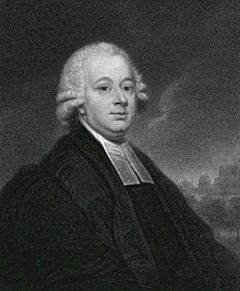Nevil Maskelyne facts for kids
Quick facts for kids
Nevil Maskelyne
FRS FRSE
|
|
|---|---|
 |
|
| Born | 6 October 1732 London, England
|
| Died | 9 February 1811 (aged 78) Greenwich, Kent, England
|
| Title | Astronomer Royal |
| Awards | Royal Society Copley Medal (1775) |
| Scientific career | |
| Fields | Astronomy |
| Institutions |
|
Nevil Maskelyne (born October 6, 1732 – died February 9, 1811) was a very important British astronomer. He was the fifth person to hold the special job of Astronomer Royal from 1765 to 1811. This meant he was the main government astronomer in Britain.
Maskelyne was the first scientist to figure out the actual weight, or mass, of our planet Earth. He also created a very important book called the British Nautical Almanac. This book helped sailors find their way using the stars and the Moon.
Contents
About Nevil Maskelyne
Nevil Maskelyne was born in London, England. His father passed away when Nevil was only 12 years old. This meant his family faced financial difficulties. He went to Westminster School. While he was there, his mother also died in 1748.
Nevil became very interested in astronomy during his time at Westminster School. This happened shortly after he saw an eclipse in 1748. An eclipse is when one space object blocks the light from another.
His Education and Early Career
In 1749, Maskelyne went to St Catharine's College, Cambridge university. He finished his studies in 1754. He became a minister in the church in 1755. He also became a member of the important Royal Society in 1758. This society is for top scientists.
Later, in 1771, he was chosen to be a member of the American Philosophical Society. This showed how respected he was in the science world.
Family Life and Passing
Nevil Maskelyne married Sophia Rose in 1784. They had one child, a daughter named Margaret. Maskelyne is buried in the churchyard of St Mary the Virgin in Purton, England.
Maskelyne's Scientific Work
Nevil Maskelyne did many important things in his career. He helped sailors find their way at sea. He also helped measure the Earth itself.
Finding Longitude at Sea
In 1760, Maskelyne went on a trip to the island of Saint Helena. He was supposed to watch the transit of Venus. This is when Venus passes in front of the Sun. Scientists wanted to use this to measure how far Earth is from the Sun. Bad weather stopped him from seeing it.
However, during this trip, Maskelyne tested a new way to find a ship's longitude. Longitude is a measurement of how far east or west a place is. He used the position of the Moon to do this. This method became known as the lunar distance method.
He wrote a book in 1763 called The British Mariner's Guide. It explained his lunar distance method. He suggested that tables showing the Moon's positions should be published every year. This would make it easier for sailors to use his method.
The Longitude Prize
In 1763, Maskelyne was sent to Barbados. His job was to test three different ways to find longitude. The British government had offered a big prize, called the Longitude prize, to anyone who could solve this problem.
One method was a special clock made by John Harrison. Another was using Moon tables created by Tobias Mayer. Both methods worked well. Harrison's clock was very accurate. Maskelyne's lunar distance method was also very good.
Maskelyne reported his findings in 1765. Soon after, he became the Astronomer Royal. This meant he was in charge of creating the yearly The Nautical Almanac. This book helped sailors all over the world. The observations for this book were made at the Royal Greenwich Observatory. Because of this, the Greenwich meridian became the main line for measuring longitude around the world.
Measuring Earth's Mass
In 1772, Maskelyne suggested a special experiment. It was called the Schiehallion experiment. It was named after a mountain in Scotland. The goal was to figure out the Earth's density, or how much it weighs for its size.
Maskelyne did the experiment in 1774. He used a plumb line, which is a string with a weight on it. It usually points straight down. But near a big mountain, the mountain's gravity pulls the plumb line slightly sideways. By measuring this tiny pull, scientists could calculate the mountain's mass. Then, they could use that to estimate the Earth's mass.
From Maskelyne's measurements, scientists figured out that Earth is about 4.5 times denser than water. Today, we know the actual value is very close to that.
Other Contributions
Maskelyne also made other improvements in astronomy. He helped measure time more accurately, down to tenths of a second. He also pushed for better instruments at the observatory.
Maskelyne in Books and TV
- Maskelyne is an important character in the book Longitude: The True Story of a Lone Genius Who Solved the Greatest Scientific Problem of His Time by Dava Sobel. There was also a TV show based on this book where he was played by Samuel West.
- He also appears in the novel Mason & Dixon by Thomas Pynchon.
- In the novel The Lieutenant by Kate Grenville, he is shown as "Dr. Vickery."
Honours and Recognition
Nevil Maskelyne received many awards and honours for his scientific work:
- In 1775, he won the Copley Medal from the Royal Society. This is a very high honour for scientists.
- In 1776, he became a member of the Russian Academy of Sciences.
- In 1778, he was chosen as an honorary member of the American Academy of Arts and Sciences.
- A crater on the Moon, located in the Sea of Tranquility, is named after him.
- The Maskelyne Islands in Vanuatu were named after him by explorer William Wales during James Cook's second voyage.
Images for kids



